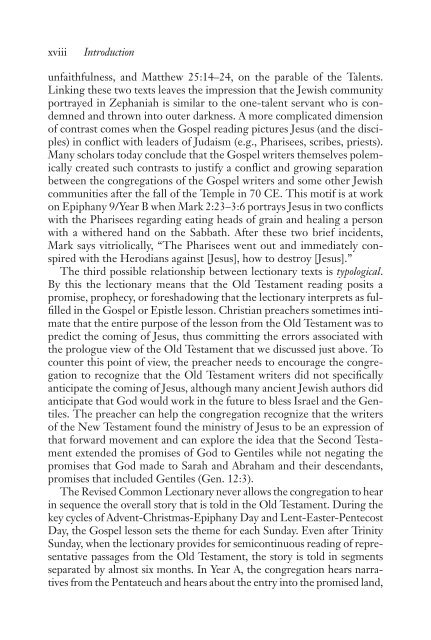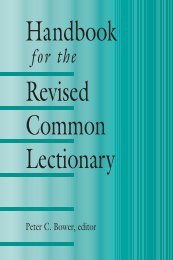- Page 1: Preaching the Old Testament
- Page 4 and 5: © 2007 Ronald J. Allen and Clark M
- Page 7 and 8: Contents Introduction xiii Year A F
- Page 9 and 10: Contents ix Third Sunday of Advent/
- Page 11 and 12: Contents xi Ash Wednesday/Year C 22
- Page 13 and 14: Introduction This volume is a compa
- Page 15 and 16: Introduction xv Preachers and congr
- Page 17: Introduction xvii than fifty-five O
- Page 21: Introduction xxi As noted previousl
- Page 24 and 25: 2 Second Sunday of Advent/Year A an
- Page 26 and 27: 4 Third Sunday of Advent/Year A We
- Page 28 and 29: 6 Fourth Sunday of Advent/Year A Is
- Page 30 and 31: 8 Christmas Day 1/Years A, B, and C
- Page 32 and 33: 10 Christmas Day 3/Years A, B, and
- Page 34 and 35: 12 First Sunday after Christmas Day
- Page 36 and 37: 14 Epiphany of the Lord/Years A, B,
- Page 38 and 39: 16 First Sunday after the Epiphany/
- Page 40 and 41: 18 Second Sunday after the Epiphany
- Page 42 and 43: 20 Fifth Sunday after the Epiphany/
- Page 44 and 45: 22 Sixth Sunday after the Epiphany/
- Page 46 and 47: 24 Seventh Sunday after the Epiphan
- Page 48 and 49: 26 Eighth Sunday after the Epiphany
- Page 50 and 51: 28 Last Sunday after the Epiphany/Y
- Page 52 and 53: 30 Ash Wednesday/Years A, B, and C
- Page 54 and 55: 32 First Sunday in Lent/Year A had
- Page 56 and 57: 34 Third Sunday in Lent/Year A Sara
- Page 58 and 59: 36 Fourth Sunday in Lent/Year A 8:1
- Page 60 and 61: 38 Palm/Passion Sunday/Years A, B,
- Page 62 and 63: 40 Good Friday/Year A name” being
- Page 64 and 65: 42 Easter Day/Year A the power to r
- Page 66 and 67: 44 Trinity Sunday/Year A in Egypt.
- Page 68 and 69:
46 Proper 4 [9]/Year A cosmic world
- Page 70 and 71:
48 Proper 5 [10]/Year A immediately
- Page 72 and 73:
50 Proper 6 [11]/Year A God does no
- Page 74 and 75:
52 Proper 6 [11]/Year A Law and sto
- Page 76 and 77:
54 Proper 8 [13]/Year A referring t
- Page 78 and 79:
56 Proper 8 [13]/Year A deeper fait
- Page 80 and 81:
58 Proper 9 [14]/Year A would give
- Page 82 and 83:
60 Proper 10 [15]/Year A case, howe
- Page 84 and 85:
62 Proper 10 [15]/Year A This text
- Page 86 and 87:
64 Proper 11 [16]/Year A 10/Year A)
- Page 88 and 89:
66 Proper 11 [16]/Year A weeping an
- Page 90 and 91:
68 Proper 12 [17]/Year A At a well
- Page 92 and 93:
70 Proper 13 [18]/Year A ancient Ne
- Page 94 and 95:
72 Proper 14 [19]/Year A turn the p
- Page 96 and 97:
74 Proper 15 [20]/Year A a theologi
- Page 98 and 99:
76 Proper 16 [21]/Year A sabbath .
- Page 100 and 101:
78 Proper 16 [21]/Year A The story
- Page 102 and 103:
80 Proper 17 [22]/Year A bush (or t
- Page 104 and 105:
82 Proper 17 [22]/Year A Hebrew mea
- Page 106 and 107:
84 Proper 18 [23]/Year A Each famil
- Page 108 and 109:
86 Proper 19 [24]/Year A in Babylon
- Page 110 and 111:
88 Proper 19 [24]/Year A Exodus 15:
- Page 112 and 113:
90 Proper 20 [25]/Year A and Abraha
- Page 114 and 115:
92 Proper 20 [25]/Year A people to
- Page 116 and 117:
94 Proper 21 [26]/Year A Ezekiel 18
- Page 118 and 119:
96 Proper 22 [27]/Year A nationalis
- Page 120 and 121:
98 Proper 22 [27]/Year A it), our n
- Page 122 and 123:
100 Proper 23 [28]/Year A Moses has
- Page 124 and 125:
102 Proper 24 [29]/Year A Israel, n
- Page 126 and 127:
104 Proper 24 [29]/Year A The Lord
- Page 128 and 129:
106 Proper 25 [30]/Year A Moses “
- Page 130 and 131:
108 Proper 26 [31]/Year A to work i
- Page 132 and 133:
110 Proper 27 [32]/Year A Proper 27
- Page 134 and 135:
112 Proper 27 [32]/Year A Amos 5:18
- Page 136 and 137:
114 Proper 28 [33]/Year A the commu
- Page 138 and 139:
116 Proper 28 [33]/Year A The sermo
- Page 140 and 141:
118 Proper 29 [34]/Year A Today’s
- Page 142 and 143:
120 Thanksgiving Day/Year A etc.”
- Page 145 and 146:
Year B First Sunday of Advent/Year
- Page 147 and 148:
Second Sunday of Advent/Year B 125
- Page 149 and 150:
Third Sunday of Advent/Year B 127 1
- Page 151 and 152:
First Sunday after Christmas Day/Ye
- Page 153 and 154:
Second Sunday after the Epiphany/Ye
- Page 155 and 156:
Fourth Sunday after the Epiphany/Ye
- Page 157 and 158:
Fifth Sunday after the Epiphany/Yea
- Page 159 and 160:
Seventh Sunday after the Epiphany/Y
- Page 161 and 162:
Ninth Sunday after the Epiphany/Yea
- Page 163 and 164:
as equals with owners is an experie
- Page 165 and 166:
The Gospel reading for today does n
- Page 167 and 168:
Fourth Sunday in Lent/Year B Number
- Page 169 and 170:
Fifth Sunday in Lent/Year B 147 the
- Page 171 and 172:
While we do not think that God is t
- Page 173 and 174:
(v. 3), which the seraphs sing to o
- Page 175 and 176:
practices of the culture? And at wh
- Page 177 and 178:
For other allusions to Genesis 3, s
- Page 179 and 180:
Proper 7 [12]/Year B 157 the Philis
- Page 181 and 182:
do not, and neither here nor in Job
- Page 183 and 184:
Proper 8 [13]/Year B 161 Lamentatio
- Page 185 and 186:
speaks directly about David fifty-s
- Page 187 and 188:
Proper 10 [15]/Year B 2 Samuel 6:1-
- Page 189 and 190:
a prophetic campaign, but Israel la
- Page 191 and 192:
contrast to the false teaching/shep
- Page 193 and 194:
Proper 12 [17]/Year B 171 spiritual
- Page 195 and 196:
While the New Testament does not ci
- Page 197 and 198:
Proper 15 [20]/Year B 1 Kings 2:10-
- Page 199 and 200:
Given this situation, the writer un
- Page 201 and 202:
Verses 41-43 address a topic of per
- Page 203 and 204:
Proper 17 [22]/Year B 181 64-68; 29
- Page 205 and 206:
Proverbs 22:8 states an important p
- Page 207 and 208:
peration they will seek but not fin
- Page 209 and 210:
Proper 20 [25]/Year B 187 emphases
- Page 211 and 212:
Purim is from the Hebrew word for
- Page 213 and 214:
Proper 22 [27]/Year B 191 compare,
- Page 215 and 216:
Proper 23 [28]/Year B 193 than Job
- Page 217 and 218:
shelter to some so that we may have
- Page 219 and 220:
ments of life are systemically inte
- Page 221 and 222:
The New Testament does not refer di
- Page 223 and 224:
Proper 27 [32]/Year B 201 some in t
- Page 225 and 226:
Proper 28 [33]/Year B 203 The books
- Page 227 and 228:
Proper 28 [33]/Year B 205 to resist
- Page 229 and 230:
say that David calls Jesus “Lord
- Page 231 and 232:
Wisdom 3:1-9 All Saints/Year B 209
- Page 233 and 234:
Year C First Sunday of Advent/Year
- Page 235 and 236:
Second Sunday of Advent/Year C 213
- Page 237 and 238:
Third Sunday of Advent/Year C 215 T
- Page 239 and 240:
Fourth Sunday of Advent/Year C 217
- Page 241 and 242:
First Sunday after the Epiphany/Yea
- Page 243 and 244:
Third Sunday after the Epiphany/Yea
- Page 245 and 246:
Fourth Sunday after the Epiphany/Ye
- Page 247 and 248:
Sixth Sunday after the Epiphany/Yea
- Page 249 and 250:
Last Sunday after the Epiphany/Year
- Page 251 and 252:
Ash Wednesday/Year C Joel 2:1-2, 12
- Page 253 and 254:
Second Sunday in Lent/Year C 231 re
- Page 255 and 256:
Was the disgrace having been enslav
- Page 257 and 258:
world (tikkun olam; see pp. xxi). T
- Page 259 and 260:
Trinity Sunday/Year C Proverbs 8:1-
- Page 261 and 262:
is set for dramatic effect. These p
- Page 263 and 264:
of my son!” (v. 18). Elijah does
- Page 265 and 266:
to YHWH’s demand that we act just
- Page 267 and 268:
Proper 7 [12]/Year C 245 God will r
- Page 269 and 270:
Proper 8 [13]/Year C 247 Two signif
- Page 271 and 272:
Naaman arrives at Elisha’s house
- Page 273 and 274:
thanks to God’s grace, live lives
- Page 275 and 276:
Proper 11 [16]/Year C 253 ing day o
- Page 277 and 278:
Proper 12 [17]/Year C 255 The Lord
- Page 279 and 280:
Proper 12 [17]/Year C 257 come unde
- Page 281 and 282:
Verses 8-9 return to Hosea’s them
- Page 283 and 284:
ment of hedonism and greed for whic
- Page 285 and 286:
Proper 15 [20]/Year C 263 God is th
- Page 287 and 288:
Proper 17 [22]/Year C 265 Jeremiah
- Page 289 and 290:
Sira, combining elements from the w
- Page 291 and 292:
eventuate in lower quality of life
- Page 293 and 294:
Proper 20 [25]/Year C 271 Jeremiah
- Page 295 and 296:
further envision a sermon that is i
- Page 297 and 298:
Proper 22 [27]/Year C 275 Lamentati
- Page 299 and 300:
Proper 22 [27]/Year C 277 is happen
- Page 301 and 302:
Jeremiah offers a model that has so
- Page 303 and 304:
Proper 25 [30]/Year C 281 read: “
- Page 305 and 306:
Proper 27 [32]/Year C Haggai 1:15b-
- Page 307 and 308:
Proper 27 [32]/Year C 285 friends,
- Page 309 and 310:
death and curse. “Law” illustra
- Page 311:
All Saints/Year C Daniel 7:1-3, 15-
- Page 314 and 315:
292 Notes from Paul, the Gospel wri
- Page 316 and 317:
294 Notes 14. Janzen, Genesis 12-50
- Page 318 and 319:
296 Notes 72. Ibid., 102-3, 188-92.
- Page 321 and 322:
Bibliography African American Spiri
- Page 323:
Bibliography 301 Williamson, Clark
- Page 326 and 327:
304 Index of Passages in Canonical
- Page 328 and 329:
306 Index of Passages in Canonical
- Page 330 and 331:
308 Index of Passages in Canonical




